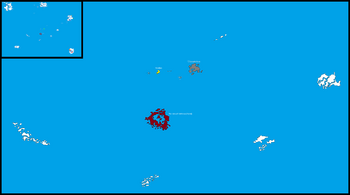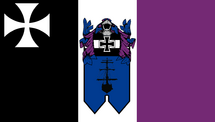Uttenstetten
This article is incomplete because it is pending further input from participants, or it is a work-in-progress by one author. Please comment on this article's talk page to share your input, comments and questions. Note: To contribute to this article, you may need to seek help from the author(s) of this page. |
Dukedom of Uttenstetten Herzogtum Uttenstetten | |
|---|---|
| Motto: "Stift & Segel des das Reich!" "Pen & Sail of the Empire!" | |
| Anthem: Kaiserlichlied | |
 Uttenstetten is a small island nation located in the center of Levanora | |
| Status | Stem-Duchy |
| Location | Central Levenora |
| Capital and | Rothenberg |
| Official languages | German |
| Recognised national languages | English, German |
| Ethnic groups (2023) | Caucasian (82%) Other (18%) |
| Religion | Kirche der Königlich ("Church of the Royal") |
| Demonym(s) | Utten or Stetten, Commoner |
| Government | Corporatocratic Feudal Monarchy, Absolute Monarchy |
• Emperor | Emperor JC |
• Duke | Otto von Adalberht Uttenstetten |
| Hartmut Mattis Sigimar | |
| Legislature | Uttenstetten Diet |
| Board of Earls | |
| Uttenstetten Executive Board | |
| Colonial Stem-Duchy of TECT | |
• Founded 1421 | Summer, 1421. |
| Area | |
• Total | 78,294 km2 (30,229 sq mi) |
• Water (%) | 0.14 |
| Population | |
• 2023 census | 41,964,294 |
• Density | 662/km2 (1,714.6/sq mi) |
| GDP (PPP) | 2023 estimate |
• Total | $21.8 Trillion NSD |
• Per capita | $89,098 NSD |
| Gini (2023) | 31 medium |
| HDI (2020) | very high |
| Currency | Imperial Dollar ($) |
| Time zone | Utten Time |
| Calling code | +108 |
| Internet TLD | .tct |
"Uttenstetten", formally known as the "Dukedom of Uttenstetten," is a Colonial Stem-Duchy within The Empire of Common Territories (TECT) located in the Levanora Vastness Region. It is comprised of a central mainland island (also named Uttenstetten) and orbited by three smaller islands in close proximity. With an area of 78,294km2, Uttenstetten is not only one of the smallest fiefdoms within the Empire but is also the Empire's smallest Stem-Duchy. Uttenstetten Island has a diverse geology which is largely tropical and dominated by three mountain ranges; Uttenstetten's mountain ranges play a pivotal role in the island's climate, often controlling conditions such as temperature and weather patterns. Rothenberg, Uttenstetten's capital and largest city, dominates the southern tip of the island while also stretching across the Rothen Bay shoreline. The remaining northern half of Uttenstetten is largely a mixture of tropical, oceanic, and some arid/temperate zones hosting smaller satellite towns/cities connected to Rothenberg.
Commoners (both native and from the Mainland) make up the vast majority of Uttenstetten's population. Roughly sixty percent of the population is native born while the remaining twenty-two percent are temporary citizens or Mainland tourists. About eighteen percent of the Uttenstetten population are temporary foreign residents or tourists. As a magnet for business and leisure, Uttenstetten is selective yet highly attractive for high-paying temporary residents (persons staying for months on end) or tourists (persons who visit for a few weeks or less). Originally setup as an outpost, Rothenberg steadily developed into a settlement, then a bustling trade port, and is now one of the largest cities within the Empire. Most of the population resides in Rothenberg and its suburbs, which dominate the southern half of Rothen Bay and line the coastline of the bay itself. Major ports towns and even remote settlements make up the rest of the population centers, often lining the island's coastline or its major rivers.
Uttenstetten is politically unique within the Empire due to its financial standing and government structure. Historically, Uttenstetten was established in the summer of 1421 after Imperial Authorities quickly realized how strategically important holding a major port city within the region could be for the Empire. The island was not only a perfect midway point between other Imperial Holdings (such as Luttenried and the Mainland, but was also surrounded by neighboring landmasses full of resources. Emperor Whilhelm XII was swift to write-up a Charter for the region, covering then Vinzent Island and its immediate waters for exploration/exploitation and development of "significant" port facilities. Although the Emperor had several nobles and trading entities in mind for various reasons, the decision to hold a public auction was decided upon namely to ensure a swift and profitable transfer of power. After a longwinded battle of budget ledgers, Alwin von Uttenstetten and his "Uttenstetten Merchant Company" successfully purchased the rights to the Vinzent Island Charter for eighteen million Imperial Dollars[a].
Notes
- ↑ $18 million Imperial Dollars back in 1400 is approximately $800 million Imperial Dollars today according to Reichsstadt University's History Department records.

